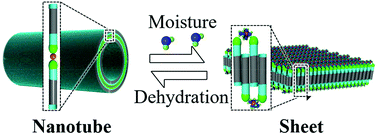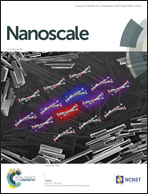Moisture-responsive supramolecular nanotubes†
Abstract
Living organisms have evolved functional structures for seeds dispersal in response to humidity changes. In this study, we construct moisture-responsive nanotubes by the supramolecular coordination of a peptide lipid with metal ions for potential applications in material delivery systems. These hydrophilic nanotubes can uptake atmospheric moisture and the water molecules are associated with unsaturated metal centers of the bis(lipid)–metal(II) complex, thereby changing the molecular packing and inducing morphological transformation from nanotubes to sheets. The moisture responsivity of nanotubes depends on the hydration behavior of the metal ions. Co(II)-coordinated nanotube shows higher moisture responsivity than that of the Zn(II)-coordinated one since Co(II) ion has stronger association with water molecules. These two nanotubes are self-assembled by the same molecular packings; however, they show different mechanisms in morphological changes. The Co(II)-coordinated nanotube transforms into a sheet accompanied with the destruction of the complex and reverse molecular packing, whereas Zn(II)-coordinated nanotube transforms into a sheet with a change in the complex geometry. Further, the Co(II)-coordinated nanotubes exhibit reversible morphological changes between nanotubes and sheets, while Zn(II)-coordinated nanotubes exhibit a one-way morphological change. These nanotubes also show potential applications in the release of fragrance oil under high humidity environments.



 Please wait while we load your content...
Please wait while we load your content...